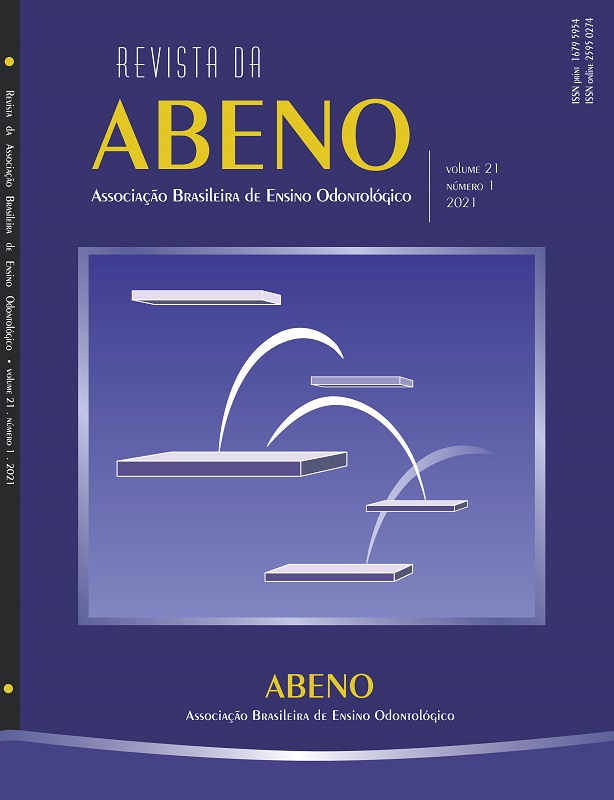Emergency management of dental avulsion and replantation
conhecimento dos estudantes de graduação na área de saúde
DOI:
https://doi.org/10.30979/revabeno.v21i1.1249Keywords:
Tooth Avulsion, Tooth Replantation, Education, Dental, First Aid, Interprofessional Education.Abstract
Dental replantation is a major problem in public health. Its prognosis depends on emergency care, but there is a lack of knowledge on it. So, this study aims to evaluate the knowledge of undergraduate students of Dentistry, Speech Therapy, Physical Education, Pedagogy, and Technologist in Radiology. One hundred and fifty one students answered 10 questions about emergency replantation care. Then, an educational lecture was performed. The same questions were asked again to the same students to reevaluate their answers. The statistical tests were employed at a significant level of p<0.05. There was a significant difference (p<0.05) on the answers before and after the lecture. The dental students had a higher knowledge of the subject (p<0.05). The educational presentation reached its objective, since there was an improvement in the index of all answers of the post-lecture questionnaire, demonstrating that the people must be informed and trained in the emergency management of dental avulsion.
Downloads
References
(1) Fouad AF, Abbott P V., Tsilingaridis G, Cohenca N, Lauridsen E, Bourguignon C, et al. International Association of Dental Traumatology guidelines for the management of traumatic dental injuries: 2. Avulsion of permanent teeth. Dent Traumatol. 2020 Aug 13;36(4):331-42.
(2) Andreasen JO, Borum MK, Jacobsen HL, Andreasen FM. Replantation of 400 avulsed permanent incisors. 4. Factors related to periodontal ligament healing. Endod Dent Traumatol. 1995;11(2):76-89.
(3) Lauridsen E, Andreasen JO, Bouaziz O, Andersson L. Risk of ankylosis of 400 avulsed and replanted human teeth in relation to length of dry storage: A re‐evaluation of a long‐term clinical study. Dent Traumatol. 2020 Apr 21;36(2):108-16.
(4) Tewari N, Goel S, Rahul M, Mathur VP, Ritwik P, Haldar P, et al. Global status of knowledge for prevention and emergency management of traumatic dental injuries among school teachers: A systematic review and meta‐analysis. Dent Traumatol. 2020 Jul 2;edt.12579.
(5) Al-Jame Q, Andersson L, Al-Asfour A. Kuwaiti parents' knowledge of first-aid measures of avulsion and replantation of teeth. Med Princ Pract. 2007;16(4):274-9.
(6) Yeng T, O'Sullivan AJ, Shulruf B. Medical doctors' knowledge of dental trauma management: A review. Dent Traumatol. 2019;(September 2019):100-7.
(7) Roskamp L, Trevilatto PC, Souza CM, Silva Neto UX, Carneiro E, Fariniuk LF, et al. Analysis of the association of clinical factors and IL4 gene polymorphisms with root resorption in avulsed teeth after 1 year of replantation. Int Endod J. 2018 Jan 15;51(1):12-9.
(8) Flores MT, Andersson L, Andreasen JO, Bakland LK, Malmgren B, Barnett F, et al. Guidelines for the management of traumatic dental injuries. II. Avulsion of permanent teeth. Dent Traumatol. 2007;23:130-6.
(9) Andersson L. Tooth avulsion and replantation. Dent Traumatol. 2007 Jun;23(3):129.
(10) Andersson L, Andreasen JO, Day P, Heithersay G, Trope M, DiAngelis AJ, et al. International Association of Dental Traumatology guidelines for the management of traumatic dental injuries: 2. Avulsion of permanent teeth. Dent Traumatol. 2012 Apr;28(2):88-96.
(11) Abd-Elmeguid A, ElSalhy M, Yu DC. Pulp canal obliteration after replantation of avulsed immature teeth: a systematic review. Dent Traumatol. 2015 Dec;31(6):437-41.
(12) Barbizam JVB, Massarwa R, da Silva LAB, da Silva RAB, Nelson-Filho P, Consolaro A, et al. Histopathological evaluation of the effects of variable extraoral dry times and enamel matrix proteins (enamel matrix derivatives) application on replanted dogs' teeth. Dent Traumatol. 2014 Oct 14;31(1):29-34.
(13) Yeng T, O'Sullivan AJ, Shulruf B. Learning about dental trauma for medical students. Dent Traumatol. 2020 Jun 8;36(3):237-40.
(14) Yeng T, O'Sullivan AJ, Shulruf B. A proposal to introduce dental trauma into medical education: An insight. Dent Traumatol. 2020 Aug 20;36(4):390-2.
(15) Trope M. Clinical management of the avulsed tooth: present strategies and future directions. Dent Traumatol. 2002;18:1-11.
(16) Zhan X, Zhang C, Dissanayaka WL, Cheung GSP, Jin L, Yang Y, et al. Storage media enhance osteoclastogenic potential of human periodontal ligament cells via RANKL-independent signaling. Dent Traumatol. 2013 Feb;29(1):59-65.
(17) Tuna EB, Arai K, Tekkesin MS, Seymen F, Gencay K, Kuboyama N, et al. Effect of fibroblast growth factor and enamel matrix derivative treatment on root resorption after delayed replantation. Dent Traumatol. 2015 Oct 7;31(1):49-56.
(18) Al-Sehaibany FS, Almubarak DZ, Alajlan RA, Aldosari MA, Alqahtani ND, Almaflehi NS, et al. Elementary school staff knowledge about management of traumatic dental injuries. Clin Cosmet Investig Dent. 2018;10:189-94.
(19) Sigurdsson A. Evidence-based Review of Prevention of Dental Injuries. J Endod. 2013 Mar;39(3):S88-93.
(20) Andrade RA, Modesto A, Evans PLS, Almeida ALS, da Silva JDJR, Guedes AML, et al. Prevalence of oral trauma in Para-Pan American Games athletes. Dent Traumatol. 2013 Aug;29(4):280-4.
(21) Nagata JY, Góis VLDA, Münchow EA, Albuquerque MTP. Dental trauma education intervention as a positive influence among undergraduate students. Eur J Dent. 2018 Oct 23;12(04):502-7.
Downloads
Published
How to Cite
Issue
Section
License
Copyright (c) 2021 Revista da ABENO

This work is licensed under a Creative Commons Attribution-NonCommercial 4.0 International License.
Autores que publicam nesta revista concordam com os seguintes termos:
a) Autores mantém os direitos autorais e concedem à revista o direito de primeira publicação, com o trabalho simultaneamente licenciado sob a Licença Creative Commons Attribution que permite o compartilhamento do trabalho com reconhecimento da autoria e publicação inicial nesta revista.
b) Autores têm autorização para assumir contratos adicionais separadamente, para distribuição não-exclusiva da versão do trabalho publicada nesta revista (ex.: publicar em repositório institucional ou como capítulo de livro), com reconhecimento de autoria e publicação inicial nesta revista.
c) Autores têm permissão e são estimulados a publicar e distribuir seu trabalho online (ex.: em repositórios institucionais ou na sua página pessoal) a qualquer ponto antes ou durante o processo editorial, já que isso pode gerar alterações produtivas, bem como aumentar o impacto e a citação do trabalho publicado (Veja O Efeito do Acesso Livre).






